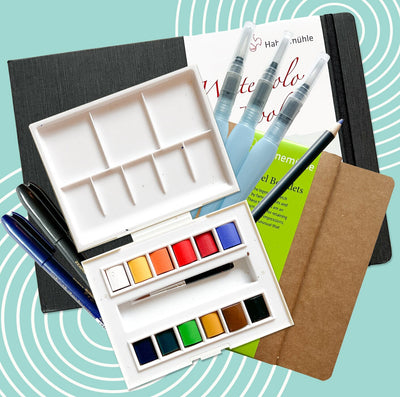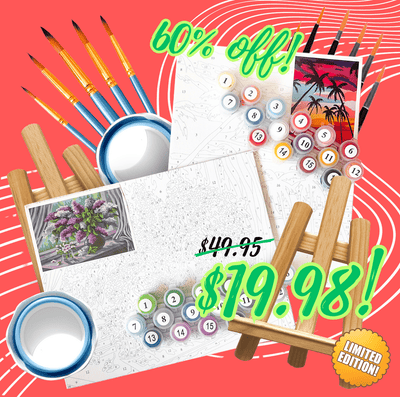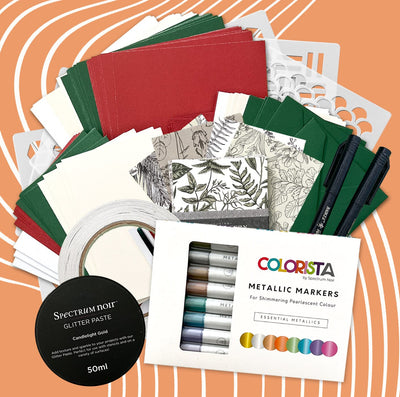Marbling is a long-standing and elegant art form, often used to decorate paper for calligraphy, bookbinding, collage, and stationery. With traditional marbling techniques, each paper created is unique, meaning that no two marbled papers are exactly alike.
One of the beautiful draws of marbling is how it allows you to maintain control over the design’s composition and while also enjoying the spontaneous flow of the colors on water. It's within your control to choose the colors, marbling techniques, and placement. At the same time, you lose some of your control over the composition when the colors spread into each other, creating designs that we wouldn’t otherwise be able to create purposefully.
Here, we'll go over some of the diverse origins of certain marbling techniques, and then we'll talk about some fun techniques to try in your own home.

A Brief History of Marbling
Several cultures have developed their own styles and techniques for paper marbling, including Chinese marbling, Japanese Suminagashi, or ‘floating ink’ marbling, Turkish Ebru marbling, marbling for Middle-Eastern and Islamic calligraphy, and European marbling, which began as a borrowed technique from the Turkish marbling tradition. In Western art, marbled papers became popular during the Renaissance for its use in bookbinding.
While European marbling and Ebru tend toward vibrant and saturated pigment-based colors, Suminagashi and other Eastern styles tend towards a more minimalistic color transfer using Sumi inks to create delicate and wispy designs. The difference between ink and paint for water transferring requires careful formulas and particular techniques. For example, since Ebru is most often created by floating denser paints and pigments used in gouache, it requires a balancing medium that allows the paint to float.
There are many design techniques that have been developed for marbling. Suminagashi techniques spread the ink across the surface of the water by fanning or gently blowing the ink. This means there's a very limited amount of control over how the ink spreads and flows, which creates elegant and organic designs. European marbling frequently uses paint dropping, combs, and dragging techniques to achieve swirling designs.
For a long time, marbling techniques, particularly in Europe, were carefully guarded secrets that masters made sure not to tell anyone. This gave rise to marbling guilds throughout the Renaissance that closely kept the artisanal secrets. At the same time, it allowed a surge of both collaborative and competitive innovation and creativity. These secrets include the formulas used for the paints and mediums, as well as the particular composition techniques used to create their eye-catching designs.
The time for secrecy has passed now, and we’re here to let you in on five techniques to get you started with your own unique marbling.

5 Fun Marbling Techniques to Try
Each marbling technique requires a willingness to experiment and try out different styles and consistencies.
In some cases, you might have to thicken the water to keep your desired medium floating on top. Many marbling artists use water-soluble methylcellulose to thicken the water and keep the pigments from sinking.
The paper is also an important factor in how well color transfers to the paper. For best results, using a spray bottle to cover the paper in water-soluble alum will help the vibrant colors to transfer.
Remember, if your marbling isn’t turning out as crisp or colorful as you would like it to, the paper might the problem. Some papers absorb ink and pigment better than others, so don’t be afraid to experiment with the paper as well as your favorite techniques.
1. Ink Marbling
If you want to create very light marbling effects, similar to those of the traditional suminagashi styles, using ink is a good option. This technique creates a soft light marbling that you can easily draw over, write a letter on, or make calligraphy over.
For best effects, thicken the water before dropping your ink on top of it. Gently drop the ink, and then swirl either by fanning or with some kind of spoon. Work gently. Since ink is likely to flow and run, too much disturbance may simply dye the paper rather than marbling it, so be careful not to overmix.
2. Nail Polish Marbling
Nail polish marbling is a good option for marbling on different surfaces and substrates since it tends to be more permanent than other home marbling methods. The nail polish method does tend to have a distinctive smell, however, and it requires adult supervision.
Most nail polish will float on water automatically, but the key is to work quickly and finish your marbling before it does sink to the bottom. When you’re ready, gently press the item that you want to marble into the nail polish, then remove it and allow it to dry.
3. Spray Paint Marbling
Marble large sheets of paper with eyepopping colors by using spray paint. This is also a good way of adding some vibrant metallic colors, such as gold and silver into your marbling. Since spray paint has a strong odor, make sure to work outside or in a well-ventilated area.
With this technique, it’s best to work rapidly. Apply the spray paints to the surface of the water for marbling. Then, stir or arrange the colors. Quickly apply the paper to the surface and remove it.
4. Oil Paint Marbling
Oil paint marbling is one of your best options for creating a vibrant marbled artwork. Not only do the colors remain vibrant, but the oil paints also give you the most control over the design or image. Keep in mind, however, that since oil paint will remain on the surface of the paper, you may not have as much freedom to draw or paint over the design.
This technique requires genuine oil paints and thickened water. Make sure to do some tests before beginning. Since oil paint can be dense, your testing should make sure that the pigments float on top of the water. Dilute the paint to the point that it’s still thick enough to be vibrant but not so thick that you can’t drop of blend the colors. Then use tools to stir and shape the colors how you want them.
5. Food Coloring and Shaving Cream Marbling
This is a great technique to try if you have children who want to join in on the marbling fun. All marbling is liable to get messy, but this one takes the cake, especially when kids are involved.
This technique is as simple as swirling the food coloring into a layer of shaving cream, creating the design you like, and then press the paper down onto the layer of shaving cream, evening it out as you go. And then scraping off the shaving cream once you remove the paper.

There are many techniques for marbling paper, so the key is to keep experimenting and have some fun with it. Let us know in the comments what works for you!


